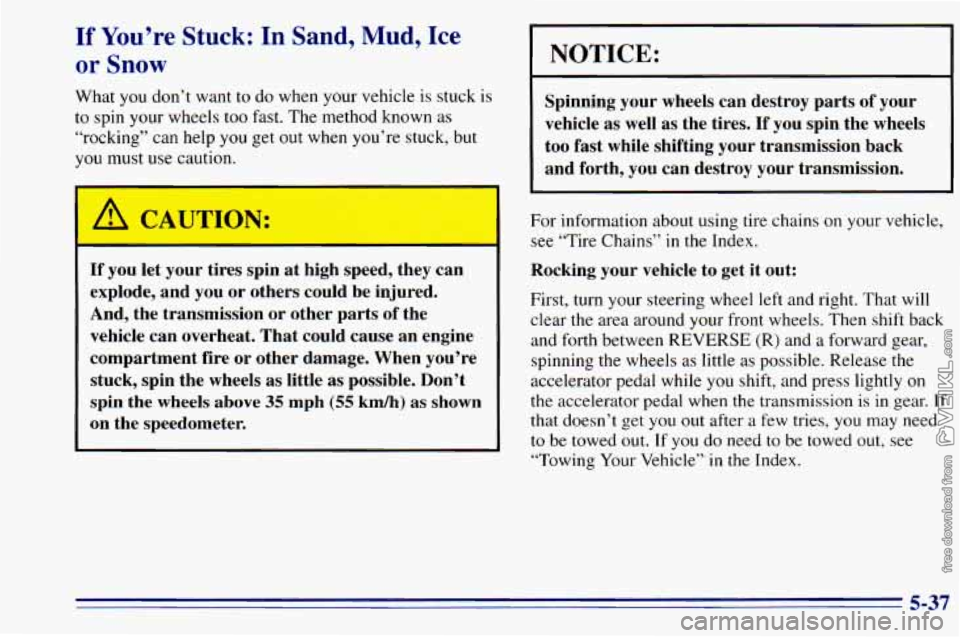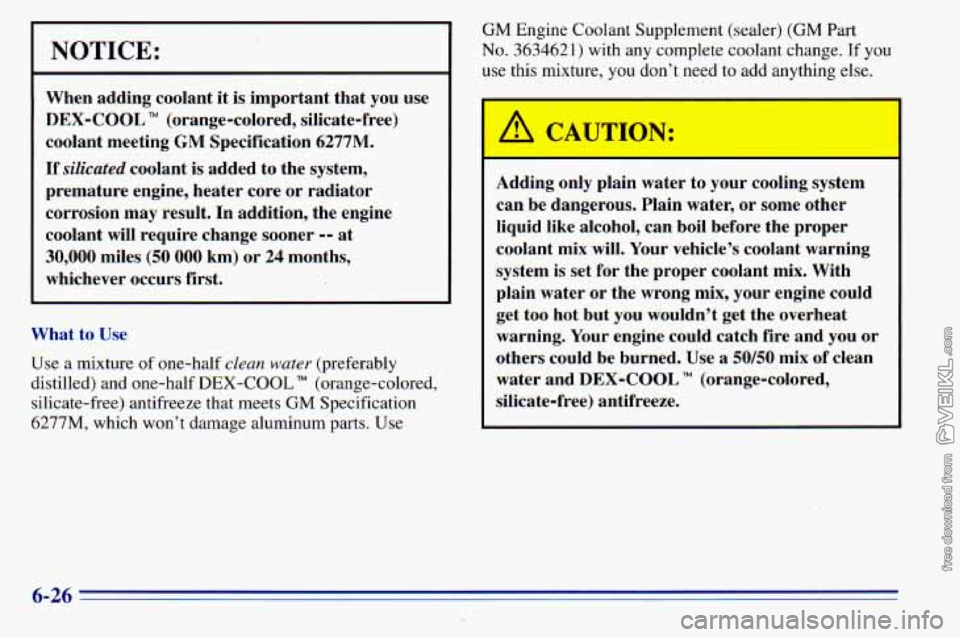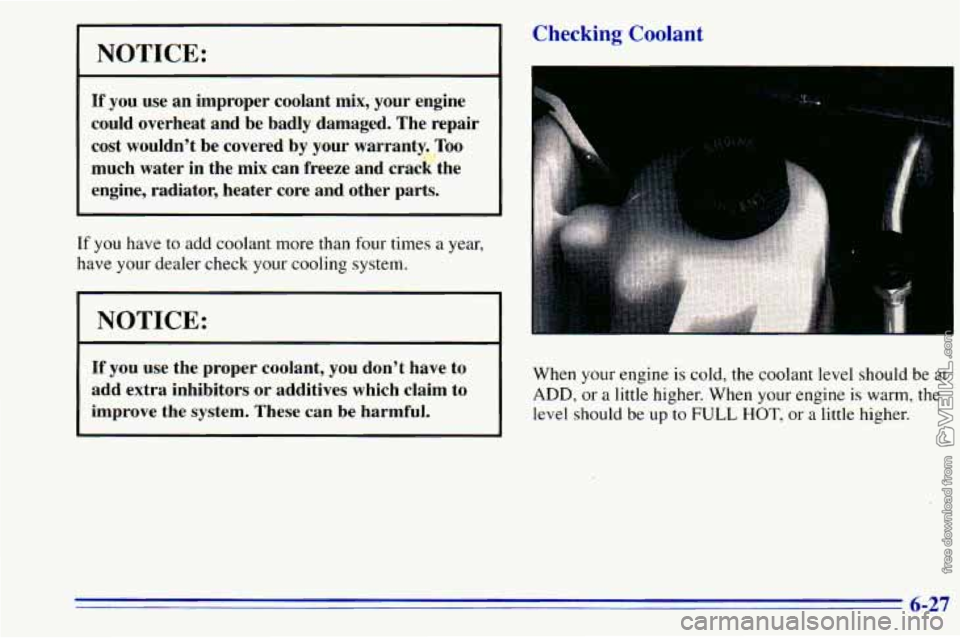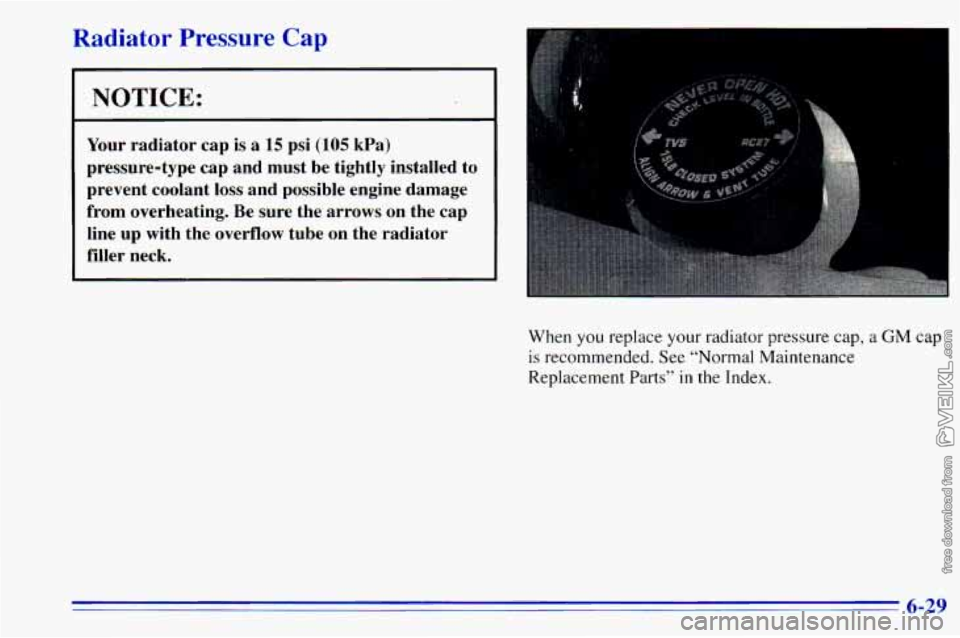1996 CHEVROLET ASTRO engine overheat
[x] Cancel search: engine overheatPage 208 of 372

Heater and radiator hoses, and other engine
parts, can be
very hot. Don’t touch them. If you
do, you can be burned.
Don’t run the engine if there is a leak.
If you run
the engine, it could lose
all coolant. That could
cause an engine fire, and you could be burned.
Get any leak fixed before you drive the vehicle.
Engine damage from running your engine without coolant isn’t covered by your warranty.
If there seems to be
no leak, start the engine again. See
if the fan speed increases when idle speed
is doubled by
pushing the accelerator pedal down.
If it doesn’t, your
vehicle needs service. Turn off the engine.
How to Add Coolant to the Coolant
Recovery Tank
If you haven’t found a problem yet, but the coolant level
isn’t at the
ADD mark, add a 50/50 mixture of clean
water (preferably distilled) and DEX-COOL TM
(orange-colored, silicate-free) antifreeze at the coolant
recovery tank. (See “Engine Coolant’’
in the Index for
more information.)
Adding only plain water to your cooling system
can be dangerous. Plain water,
or some other
liquid like alcohol, can boil before the proper
coolant mix
will. Your vehicle’s coolant warning
system is set
for the proper coolant mix. With
plain water or the wrong mix, your engine could
get too hot but you wouldn’t get the overheat
warning. Your engine could catch fire and you or
others could be burned. Use a
50/50 mix of clean
water and
DEX-COOL TM antifreeze.
5-16
Page 209 of 372

NOTICE:
In cold weather, water can freeze and crack the
engine, radiator, heater core and other parts. Use the recommended coolant and the proper
coolant mix.
I A CAUTION:
You can be burned if you spill coolant on hot
engine parts. Coolant contains ethylene glycol
and it will burn
if the engine parts are hot
enough. Don’t spill coolant on
a hot engine.
When the coolant in
the coolant recovery tank is at the
ADD mark, start your vehicle.
If the overheat warning continues, there’s one more
thing
you can try. You can add the proper coolant mix
directly
to the radiator, but be sure the cooling system is
cool before you do
it.
Page 229 of 372

If You’re Stuck: In Sand, Mud, Ice
or Snow
What you don’t want to do when your vehicle is stuck is
to spin your wheels too fast. The method known as
“rocking” can help
you get out when you’re stuck, but
you must use caution.
A CAUTION:’
I
If you let your tires spin at high speed, they can
explode, and you or others could be injured.
And, the transmission or other parts of the
vehicle can overheat. That could cause an engine
compartment fire or other damage. When you’re
stuck, spin the wheels
as little as possible. Don’t
~ spin the wheels above 35 mph (55 km/h) as shown
~ on the speedometer.
I
NOTICE:
Spinning your wheels can destroy parts of your
vehicle
as well as the tires. If you spin the wheels
too fast while shifting your transmission back
and forth, you can destroy your transmission.
For information about using tire chains
on your vehicle,
see “Tire Chains” in
the Index.
Rocking your vehicle to get it out:
First, turn your steering wheel left and right. That will
clear the area around your front wheels. Then shift back
and forth between REVERSE
(R) and a forward gear,
spinning the wheels as little as possible. Release the
accelerator pedal while you shift, and press lightly
on
the accelerator pedal when the transmission is in gear. If
that doesn’t get
you out after a few tries, you may need
to be towed out. If you do need to be towed out, see
“Towing Your Vehicle’’’ in the Index.
5-37
Page 255 of 372

What to Use Rear Axle
When to Check and Change Lubricant
Refer to the Maintenance Schedule to determine how
often to check the lubricant and when
to change it. See
“Scheduled Maintenance Services” in the Index.
How to Check Lubricant
If the level is below the bottom of the filler plug hole,
you’ll need to add some lubricant. Add enough lubricant
to raise the level to the bottom of the filler plug hole. Refer
to the Maintenance Schedule to determine what
kind of lubricant
to use. See “Recommended Fluids and
Lubricants” in the Index.
Engine Coolant
The cooling system in your vehicle is filled with new
DEX-COOL (orange-colored, silicate-free) engine
coolant. This coolant is designed to remain in your
vehicle for
5 years or 100,000 miles (166 000 km),
whichever occurs first.
The following explains your cooling system and how to
add coolant when it is low. If
you have a problem with
engine overheating, see “Engine Overheating’’ in
the Index.
A 50/50 mixture of water and the proper coolant for
your vehicle will:
0 Give freezing protection down to -34°F (-37°C).
Give boiling protection up to 265 “F (1 29°C).
0 Protect against rust and corrosion.
Help keep the proper engine temperature.
0 Let the warning lights and gages work as
they should.
6-25
Page 256 of 372

NOTICE:
When adding coolant it is important that you use
DEX-COOL
TM (orange-colored, silicate-free)
coolant meeting
GM Specification 6277M.
If silicated coolant is added to the system,
premature engine, heater core or radiator
corrosion may result. In addition, the engine
coolant will require change sooner
-- at
30,000 miles (50 000 km) or 24 months,
whichever occurs first.
What to Use
Use a mixture
of one-half clean water (preferably
distilled) and one-half
DEX-COOL (orange-colored,
silicate-free) antifreeze that meets GM Specification
6277M, which won’t damage aluminum parts. Use GM
Engine Coolant Supplement (sealer)
(GM Part
No. 3634621) with any complete coolant change. If you
use this mixture, you don’t need to add anything else.
A CAUTION:
I
Adding only plain water to your cooling system
can be dangerous. Plain water, or some other
liquid like alcohol, can boil before the proper
coolant mix will. Your vehicle’s coolant warning
system is set for the proper coolant mix. With
plain water or the wrong mix, your engine could
get too hot but
you wouldn’t get the overheat
warning. Your engine could catch fire and you or
others could be burned. Use
a 50/50 mix of clean
water and DEX-COOL (orange-colored,
silicate-free) antifreeze.
6-26
Page 257 of 372

NOTICE:
If you use an improper coolant mix, your engine
could overheat and be badly damaged. The repair
cost wouldn’t be covered by your warranty. Too
much water in the mix can freeze and crackthe
engine, radiator, heater core and other parts.
If you have to add coolant more than four times a year,
have your dealer check your cooling system.
I NOTICE: I
If you use the proper coolant, you don’t have to
add extra inhibitors or additives which claim
to
improve the system. These can be harmful.
Checking Coolant
When your engine is cold, the coolant level should be at
ADD, or a little higher. When your engine is warm, the
level should be up to
FULL HOT, or a little higher.
6-27
Page 259 of 372

Radiator Pressure Cap
NOTICE:
Your radiator cap is a 15 psi (105 kPa)
pressure-type cap and must be tightly installed to
prevent coolant loss and possible engine damage
from overheating. Be sure the arrows on the cap
line
up with the overflow tube on the radiator
filler neck.
When you replace your radiator pressure cap, a GM cap
is recommended. See “Normal Maintenance
Replacement Parts” in the Index.
6-29
Page 363 of 372

Damage. Finish ........................ . . 6-56
Damage. Sheet Metal
............................ 6-56
Daytime Running Lamps
......................... 2-36
Daytime Running Lamps Indicator Light
............ 2-62
Dead Battery
................................... 5-2
Defects. Reporting Safety
......................... 8-8
Defensive Driving ............................... 4- 1
Defogger. Rear Window .......................... 3-7
Defrosting
..................................... 3-6
Dimensions. Vehicle
............................ 6-69
Dome Lamps
.................................. 2-37
Door Locks
....................................... 2-5
Sliding ...................................... 2-9
DrivePosition
................................. 2-20
DriverPosition
................................. 1-16
Driving City
........................................ 4-17
Defensive
.................................... 4-1
Drunken ..................................... 4-2
Freeway
.................................... 4-18
InaBlizzard ................................. 4-24
In Foreign Countries ........................... 6-4
In the Rain .................................. 4-14
Night
...................................... 4-13
OnCurves
................................... 4-8
On Grades While Towing
a Trailer ............... 4-35
On Hill and Mountain Roads
.................... 4-20
On Snow and Ice
............................. 4-22
Through Water
................... ....... 4-16
WetRoads
.................................. 4-14
Winter ...................................... 4-22
With a Trailer ................................ 4-33
Drunken Driving
................................ 4-2 Electrical
Equipment. Adding
........ 2- 16. 3.26. 6-60
Electrical System
............................... 6-60
Engine ........................................ 4-9
Coolant
..................................... 6-25
Coolant Heater
............................... 2-16
Coolant Level Check
.......................... 7-41
Cooling System Capacity
....................... 6-67
Cover
...................................... 6-15
Exhaust
..................................... 2-26
FuseBlocks
............................ 6-61. 6-64
Identification
................................ 6-59
OilLevelCheck
.............................. 7-41
Overheating
................................. 5-13
Running While Parked
......................... 2-26
Specifications
................................ 6-67
Starting
..................................... 2-15
Temperature Gage
............................ 2-62
Engineoil
.................................... 6-11
Adding
..................................... 6-12
Additives
................................... 6-14
Checking
................................... 6-12
Pressure Gage
........................... .... 2-60
Used
....................................... 6-15
Whentochange .............................. 6-14
Exhaust. Engine
................................ 2-26
Express-Down Window
........................ 2-28
Fabric Cleaning
............................... 6-50
Fiberglass Springs
.............................. 6-57
Filling Your Tank
................................ 6-5
Filter. Air
..................................... 6-69
Filter. Engine Oil
............................... 6-69
Finish Care
.................................... 6-54
9-3